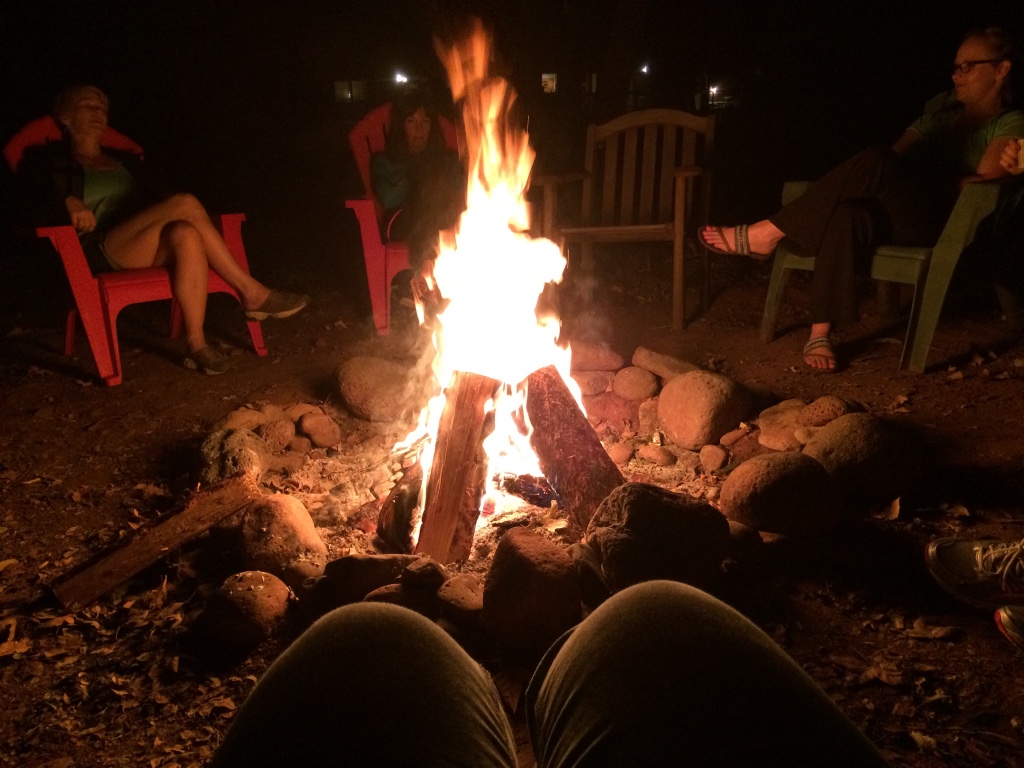Listen to Heather read the post:
Sometimes, when it has rained all day and everything is damp, it’s nearly impossible to start a fire, even if the wood was under a tarp. Last night was one of those nights. The challenge was compounded by the fact that the only paper I had on hand were the pages of my journal and I was reluctant to tear out too many.
It takes tenderness and care to start such a fire, and sometimes I don’t have the patience for it, but last night I was willing to do what it took. I tore up some paper, crumpled it at the bottom of the fire pit, and then leaned a few of the driest, thinnest pieces of kindling on top. Even the paper was a little damp, though, and it failed to flare up into enough of a flame to ignite the kindling. I tried again, and this time one of the twigs caught fire, but then it fizzled out. I blew on the bits of glow at the edges to see if I could re-ignite it, but there was only smoke. I went back into the cabin for another precious page from my journal and tried again with the same result. “This is the last piece of paper I’m tearing out,” I said to myself the third time, and this time I rationed it carefully, using only a few strips at a time.
Again, the first strips failed to ignite the kindling, but finally, with very little paper left, a tiny flame started to form. I hovered over it, adding more kindling when the fire seemed strong enough to handle it and moving bits around so that there was sufficient airflow. Gradually, I increased the size of kindling until I was fairly certain it was burning hot enough to handle a split log. Sometimes I’m impatient and add a log too soon and it buries the little flame, but this time I was wise enough to wait.
Soon, I had a strong flame, with three or four pieces of wood burning. I sat back to enjoy the warmth, after snapping a picture to celebrate my achievement. But my pride was short-lived. It was, apparently, a superficial fire, only catching the outsides of the logs but not warming enough to fully ignite what turned out to be not well-cured wood. (I could see some of the moisture emerging from inside the wood.) Before long, what had been a strong flame, had nearly fizzled out and there were only a few glowing spots on the bottoms of the logs.
Determined, I started blowing on those glowing spots, and each time I did, a flame would ignite, but then it would fizzle out again. I blew again and again, contemplating walking down the hill to my car where I had a handheld fan in my camping equipment that sometimes comes in handy for just such a purpose. I rearranged the wood for maximum airflow and ignition possibility, but still it kept fizzling out.
I considered giving up and heading back into the cabin for the night, but the Fall air was gentle, and the full moon was rising above the trees, and I just wasn’t ready to be inside. I shoved the last bits of kindling into the bottom near the glowing wood, and blew and blew.
Finally, a real, sustainable fire ignited. Finally, my effort had paid off and I could settle in to enjoy the reward. After that, all I had to do was add an occasional log and move things around a little with the cast iron poker.
Sitting there watching the flames as the moon rose higher in the sky, it occurred to me that fire-building is not unlike relationship-building. Sometimes the conditions are right and it’s easy to get one started. It just takes one match, one piece of paper, and some dry wood and soon there is a strong fire that offers warmth to those who gather round. But sometimes the conditions are more challenging. Sometimes it takes multiple matches, multiple pieces of paper, and lots of tenderness and care. Sometimes you have to rearrange things, add spaciousness so that the air can pass through, blow on it, and add wood slowly so that the flame doesn’t get smothered.
Some relationships need you to lean in with attentiveness and care, while others simply need you to show up and throw a match into the kindling. You have to pay careful attention to what each relationship needs, not smothering anyone or expecting too much of them too soon, not rushing to assume the relationship is solid before those involved have sufficiently warmed up to it. (This is true in groups as well as one-on-one relationships.)
Even with the greatest amount of care, though, sometimes a fire still fizzles out because the interior of the wood is just not ready to receive the flame. Despite your best efforts, you can’t fix the insides of the wood.
I don’t often abandon a fire that fizzles out. Once I commit to something, I can be quite stubborn about seeing it through. But occasionally, I admit defeat and let go. In those times, I have to find my source of warmth somewhere else, usually under the blankets in bed.
Sometimes we have to let go of relationships too. Sometimes, after working hard to fan the flame and nurture the warmth, we have little choice but to accept that there just wasn’t readiness for what we were hoping for and move on.
****
If you long for a space where you can have conversations about what it takes to tend to your relationships, as I tended to my fire, join us for the How to Hold Space Foundation Program. Registration will stay open until November 3rd!

